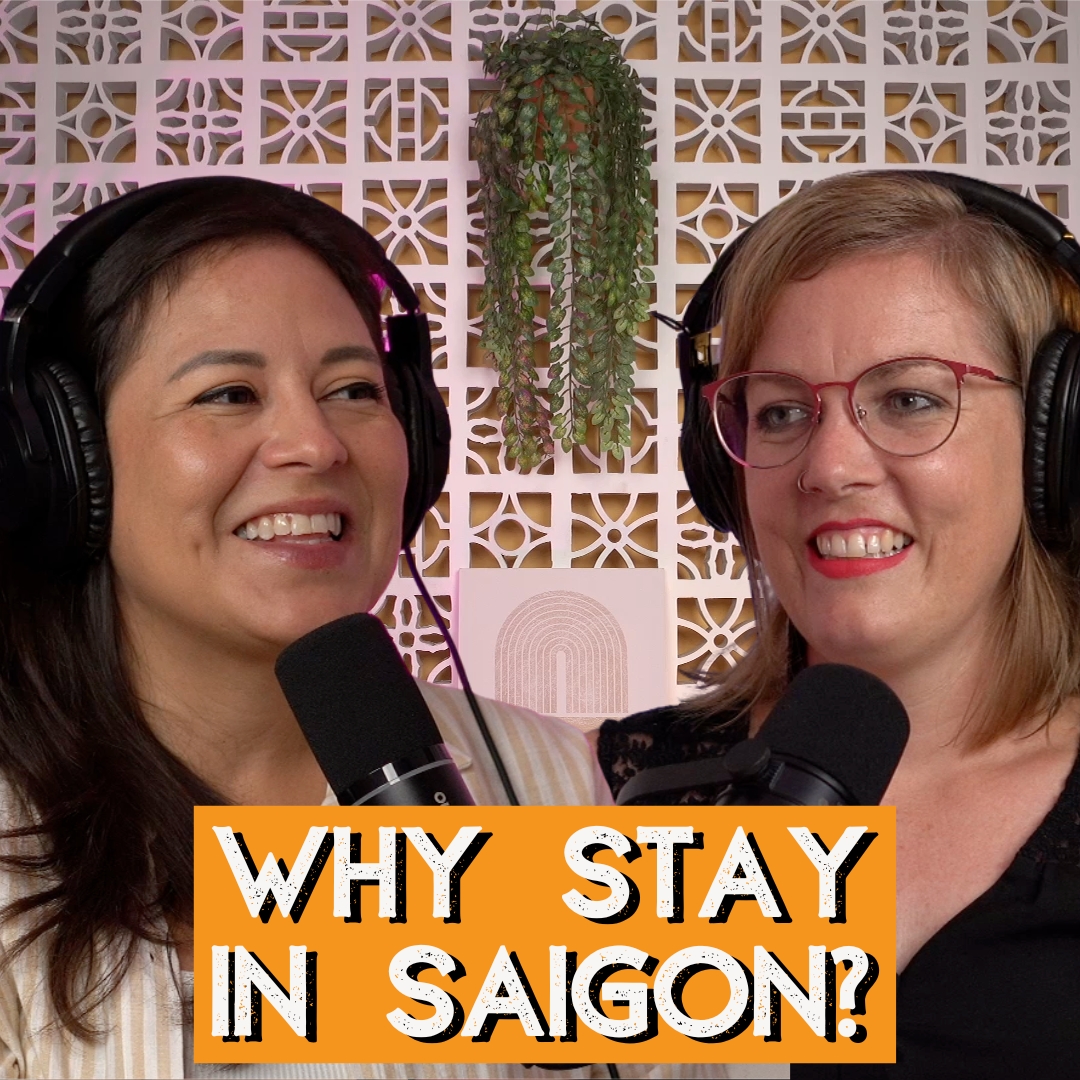This episode of the A Vietnam Podcast comes with a twist: host Adrie Lopez Mackay, my wife. While she’s been part of the podcast journey since it began, this is her debut as an interviewer.
The guest today is Krista Bernard, a Canadian who swapped a rural farming village of about 500 people—“including cows,” she jokes—for the fast-paced, ever-changing streets of Saigon. Let’s figure out her decision to stay in Saigon.
From a Canadian Village to the Bustling Streets of Saigon
Life couldn’t be more different between a quiet farming village in Canada and the buzzing, non-stop energy of Saigon. For Krista Bernard, this contrast isn’t just a travel experience—it’s her everyday reality.
Krista grew up in a rural community of about 500 people—a number she jokes “includes the cows.” Surrounded by fields and dairy farms, life was slow, predictable, and deeply connected to the seasons. Today, she calls Vietnam’s largest city home, where motorbikes swarm through the streets, skyscrapers share space with street markets, and the pace never slows.
Before moving abroad, Krista worked as a correctional officer in Canada. Four years ago, she decided to trade the calm routines of small-town life for the vibrant culture of Southeast Asia. Since then, she has lived in both Hanoi and Saigon, learning to adapt to a completely different way of life.
Her journey hasn’t been without challenges—both cultural adjustments and unexpected personal setbacks—but along the way, she has found opportunities she never imagined. Her story is one of stepping into the unknown, making the most of every circumstance, and embracing the possibilities that come with living far from home.
The Decision to Live Abroad
After finishing her studies, many of Krista’s friends followed a familiar path: move to a big city for university, then return to their hometowns to settle down. Krista’s path was different. She kept moving, kept exploring, and eventually built a life overseas.
When she returns to visit family, the question she hears most often is, “When are you moving back?” For many people in her village, the idea of living abroad is hard to imagine. But for Krista, the answer is simple—the benefits of staying overseas far outweigh the pull to return.
She receives a free round-trip flight to Canada each year, earns a competitive salary, and has easy access to travel across Asia. More importantly, she’s able to immerse herself in cultures, foods, and experiences that would be impossible to find if she had stayed put.
Living abroad has expanded her worldview in ways she sometimes struggles to explain to people back home. While she still treasures her roots, she knows her future, for now, is firmly planted in international soil.
The Move to Saigon – and an Unexpected Setback
After several years in Hanoi, Krista relocated to Saigon in search of a fresh start. She was excited to dive into the city’s energy, variety, and opportunities. But almost immediately, life threw her a curveball—she tore her ACL.
The injury changed everything. For months, walking was painful, social outings were rare, and even getting to work was a challenge. She missed the first months that most newcomers spend exploring neighborhoods, meeting people, and building a routine. Surgery in October helped, but recovery was slow. During Saigon’s rainy season, slippery tiled sidewalks made her nervous to even step outside.
Still, friends kept her connected and encouraged her through the long recovery. Gradually, her mobility returned—and with it, the chance to finally experience Saigon the way she had hoped from the beginning. That difficult first year became the foundation for some of her most rewarding experiences in Vietnam.
Discovering Saigon’s Lifestyle and Opportunities
Once Krista was back on her feet, the city opened up to her. The first thing she noticed was the food. Saigon is a paradise for anyone who loves to eat—from fragrant bowls of phở served at tiny street stalls to international restaurants offering everything from Korean BBQ to Italian pasta. Coming from a place where dining out meant choosing between a few small-town options, it felt like an endless buffet of flavors.
Beyond food, Saigon impressed her with the sheer variety of activities. She joined resin art workshops, booked a class to make a mosaic lamp, and discovered book clubs and sports teams open to newcomers. Whether you’re into painting, yoga, soccer, or cooking, the city offers a way to get involved.
Another big advantage? Saigon is one of Southeast Asia’s best-connected travel hubs. Direct flights to destinations like Australia, Korea, and Singapore make weekend trips or long holidays far more convenient than in Hanoi, where many trips required an extra stopover. For Krista, this accessibility is one of the city’s biggest draws.
Taipei vs. Saigon: Lessons from Another Asian City
Krista’s recent trip to Taipei gave her a new perspective on urban life in Asia. The first thing she noticed was the cleanliness. Despite a lack of public trash cans, people simply carried their rubbish home. Public transportation was another standout—efficient, affordable, and able to whisk passengers from the city center to rural mountain areas in under two hours.
Taipei offered a perfect balance between big-city convenience and access to nature. One day you could be exploring busy night markets, the next hiking trails with panoramic views or relaxing in a coastal village. It’s easy to see why Taipei ranks as one of the cities residents are least likely to leave.
Krista couldn’t help but think of what Saigon could learn from Taipei—especially in terms of waste management, infrastructure, and respect for shared spaces. Saigon already has incredible energy and diversity. If it could match that with Taipei’s organization and cleanliness, it would be nearly unbeatable.
The Challenges of Life in Saigon
Krista is the first to admit that Saigon isn’t perfect. Litter is a visible problem, with rubbish often tossed into the street or out of moving vehicles. While new developments like the metro hint at a cultural shift, waste management remains a challenge.
Traffic is another reality. Saigon’s size means that crossing the city can take hours, especially at rush hour. Meeting friends often requires careful planning—factoring in travel time, traffic patterns, and even the weather.
Public transport is still limited, so most people rely on motorbikes, taxis, or ride-hailing apps. The metro line is a welcome addition, and Krista hopes it will expand quickly into more districts.
Despite these hurdles, both locals and expats adapt. People learn the best travel times, stick to favorite neighborhoods, and focus on the city’s many positives. For Krista, the challenges are worth navigating for the rewards Saigon offers.
City Growth and Change
Saigon has always been large, but its recent “mega city” status—after merging with nearby provinces—makes it one of the biggest in Vietnam. As part of this change, traditional district numbers have been replaced with ward names. While most residents still use the old system in daily conversation, the update aims to streamline city administration.
The city has also become more comfortable for long-term residents. Krista remembers when cheese was expensive and hard to find, and pizzas had limited topping options—shrimp being one of the few. Now, supermarkets and specialty stores offer a range of imported goods, from gourmet cheeses to diverse pizza styles. These small but meaningful changes make Saigon even more appealing to those who choose to stay.
Reflections on Life Abroad
For Krista, Saigon offers the best of both worlds. It’s rich in Asian culture, traditions, and community spirit, yet full of Western conveniences that make life easier. This blend keeps her engaged and excited about her day-to-day life.
Living abroad has taught her adaptability, patience, and an appreciation for diversity. It’s also shown her that “home” isn’t a single location—it’s the place where you choose to build your life.
Looking ahead, she finds it hard to imagine returning to a small-town routine. Her advice for anyone considering a move abroad is simple: stay open to change, embrace differences, and take advantage of every opportunity. In her experience, the rewards far outweigh the challenges.
Conclusion – Settle Overseas
Hosting her first episode, Adrie brought a fresh perspective and a personal touch to the conversation, drawing out the moments that make Krista’s story so relatable—whether it’s navigating cultural differences, finding a sense of community, or deciding that home can be wherever you choose to make it.

